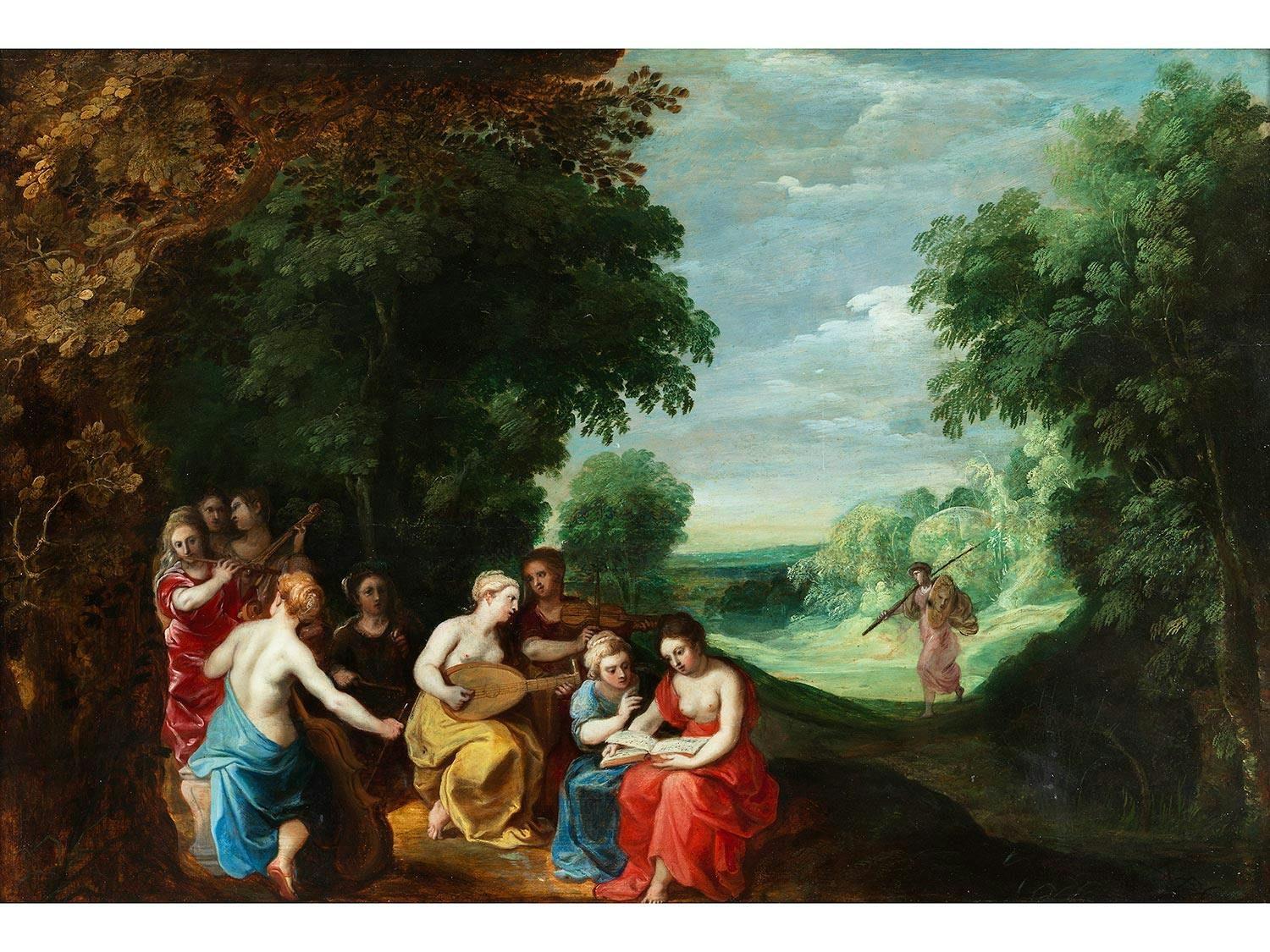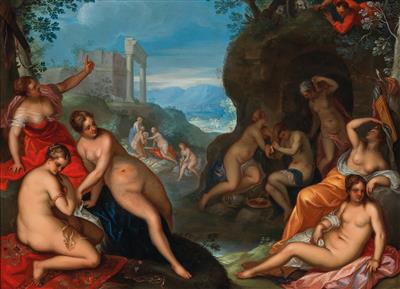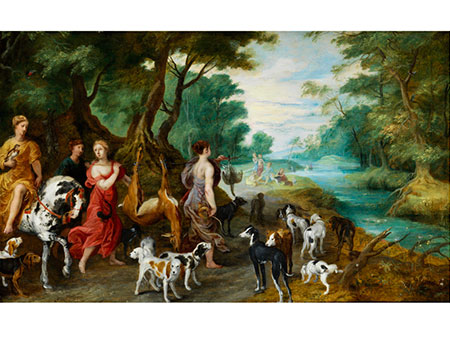(Antwerp 1575–1632) and Jan Brueghel II (Antwerp 1601–1678) Diana and her Nymphs after the Hunt, overheard by Satyrs, oil on copper, 29 x 41 cm, framed We are grateful to Klaus Ertz for confirming the attribution of the present painting to Jan Brueghel II (landscape and animals). As Ertz points out the figures have been executed by van-balen-i" title="Hendrik van Balen I">Hendrik van Balen and his studio. He dates the painting to the 1620s. A written certificate is available. Ertz writes: ‘The painting to be assessed […] is known to me in the original. Having carefully examined it, I am convinced that the figures of Diana and her nymphs, the satyrs, and the small figure of Cupid in the left background were painted by the Flemish figure painter van-balen-i" title="Hendrik van Balen I">Hendrik van Balen whereas the landscape, the dead animals, and the hunting utensils were executed by his colleague, Jan Brueghel the Younger. The five larger figures in the foreground are by the hand of van-balen-i" title="Hendrik van Balen I">Hendrik van Balen whereas the figures in the background were executed by his studio collaborators under the master’s supervision. The present painting appears to have survived in excellent condition. The colours have been applied thickly in the impasto technique and give a bright and brilliant impression. The overlapping glazes, added in several layers, are found to be in good condition, lending this painting its peculiar three-dimensionality. The paints have been spread fluidly and with broad, swift brushstrokes […]. This copper panel is further proof of the collaboration between the two Flemish painters van-balen-i" title="Hendrik van Balen I">Hendrik van Balen and Jan Brueghel the Younger. The latter had met van Balen in the studio of his father, Jan Brueghel the Elder. The collaboration between Jan the Younger and van Balen already began before Jan the Younger travelled to Italy in around 1620 as is documented by paintings executed jointly predating the Italian sojourn of Jan. But only after his father had died in 1625 and the son had taken over his studio, the collaboration of the two painters intensified. Starting in 1626, Jan II’s diary lists the first paintings produced jointly by the two painters. Van Balen became Jan the Younger’s most important collaborator and greatly helped the younger artist to quickly establish himself in Antwerp with his father’s workshop. Their extremely prosperous cooperation only ended with van Balen’s death in 1632. The model on which the present painting on copper is based was conceived by Jan Brueghel the Elder and van-balen-i" title="Hendrik van Balen I">Hendrik van Balen Diana and Her Nymphs, Overheard by Satyrs (Staatliche Kunstsammlungen, Dresden, circa 1620). In both the Dresden painting and the painting to be assessed here, van Balen has rendered the feminine charm of the female figures in an impressive variety. The intensity of the colours is augmented by the copper support, resulting in an enamel-like shine of the fleshtones. The contrast between the light-coloured female bodies and the surrounding landscape is enhanced by the colourful pieces of cloth and, above all, the dark-red scarf in the background, as well as the coarsely rendered satyrs with their lecherous gazes. The spectator almost finds himself in the same voyeuristic situation as the two satyrs. For in both compositions, Diana and her sleeping nymphs sit on a grassy elevation illuminated by bright light, like actresses on a stage.’ To corroborate his attribution, Ertz compares the present painting to the following collaborative works by van-balen-i" title="Hendrik van Balen I">Hendrik van Balen and Jan Brueghel II: The Rape of Europa (Kunsthistorisches Museum, Vienna, circa 1621/22); Diana’s Nymphs after the Hunt (German private collection, late 1620s); Diana and Her Nymphs Bathing (French private collection, late 1620s); Plucking the Herons (German private collection, 1627). Ertz adds: ‘In my opinion, the painting to be assessed here must also have been painted towards the late 1620s. This date would fit in with the painterly and spirited brushwork that marks the beginning of Jan’s independent development in the landscape genre – a deve
(Antwerp 1575–1632) and Jan Brueghel II (Antwerp 1601–1678) Diana and her Nymphs after the Hunt, overheard by Satyrs, oil on copper, 29 x 41 cm, framed We are grateful to Klaus Ertz for confirming the attribution of the present painting to Jan Brueghel II (landscape and animals). As Ertz points out the figures have been executed by van-balen-i" title="Hendrik van Balen I">Hendrik van Balen and his studio. He dates the painting to the 1620s. A written certificate is available. Ertz writes: ‘The painting to be assessed […] is known to me in the original. Having carefully examined it, I am convinced that the figures of Diana and her nymphs, the satyrs, and the small figure of Cupid in the left background were painted by the Flemish figure painter van-balen-i" title="Hendrik van Balen I">Hendrik van Balen whereas the landscape, the dead animals, and the hunting utensils were executed by his colleague, Jan Brueghel the Younger. The five larger figures in the foreground are by the hand of van-balen-i" title="Hendrik van Balen I">Hendrik van Balen whereas the figures in the background were executed by his studio collaborators under the master’s supervision. The present painting appears to have survived in excellent condition. The colours have been applied thickly in the impasto technique and give a bright and brilliant impression. The overlapping glazes, added in several layers, are found to be in good condition, lending this painting its peculiar three-dimensionality. The paints have been spread fluidly and with broad, swift brushstrokes […]. This copper panel is further proof of the collaboration between the two Flemish painters van-balen-i" title="Hendrik van Balen I">Hendrik van Balen and Jan Brueghel the Younger. The latter had met van Balen in the studio of his father, Jan Brueghel the Elder. The collaboration between Jan the Younger and van Balen already began before Jan the Younger travelled to Italy in around 1620 as is documented by paintings executed jointly predating the Italian sojourn of Jan. But only after his father had died in 1625 and the son had taken over his studio, the collaboration of the two painters intensified. Starting in 1626, Jan II’s diary lists the first paintings produced jointly by the two painters. Van Balen became Jan the Younger’s most important collaborator and greatly helped the younger artist to quickly establish himself in Antwerp with his father’s workshop. Their extremely prosperous cooperation only ended with van Balen’s death in 1632. The model on which the present painting on copper is based was conceived by Jan Brueghel the Elder and van-balen-i" title="Hendrik van Balen I">Hendrik van Balen Diana and Her Nymphs, Overheard by Satyrs (Staatliche Kunstsammlungen, Dresden, circa 1620). In both the Dresden painting and the painting to be assessed here, van Balen has rendered the feminine charm of the female figures in an impressive variety. The intensity of the colours is augmented by the copper support, resulting in an enamel-like shine of the fleshtones. The contrast between the light-coloured female bodies and the surrounding landscape is enhanced by the colourful pieces of cloth and, above all, the dark-red scarf in the background, as well as the coarsely rendered satyrs with their lecherous gazes. The spectator almost finds himself in the same voyeuristic situation as the two satyrs. For in both compositions, Diana and her sleeping nymphs sit on a grassy elevation illuminated by bright light, like actresses on a stage.’ To corroborate his attribution, Ertz compares the present painting to the following collaborative works by van-balen-i" title="Hendrik van Balen I">Hendrik van Balen and Jan Brueghel II: The Rape of Europa (Kunsthistorisches Museum, Vienna, circa 1621/22); Diana’s Nymphs after the Hunt (German private collection, late 1620s); Diana and Her Nymphs Bathing (French private collection, late 1620s); Plucking the Herons (German private collection, 1627). Ertz adds: ‘In my opinion, the painting to be assessed here must also have been painted towards the late 1620s. This date would fit in with the painterly and spirited brushwork that marks the beginning of Jan’s independent development in the landscape genre – a deve





.jpg)

.jpg)







Try LotSearch and its premium features for 7 days - without any costs!
Be notified automatically about new items in upcoming auctions.
Create an alert